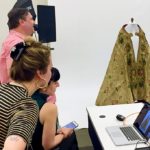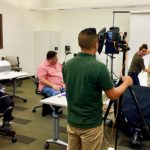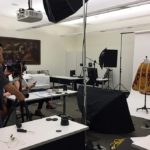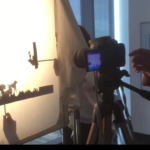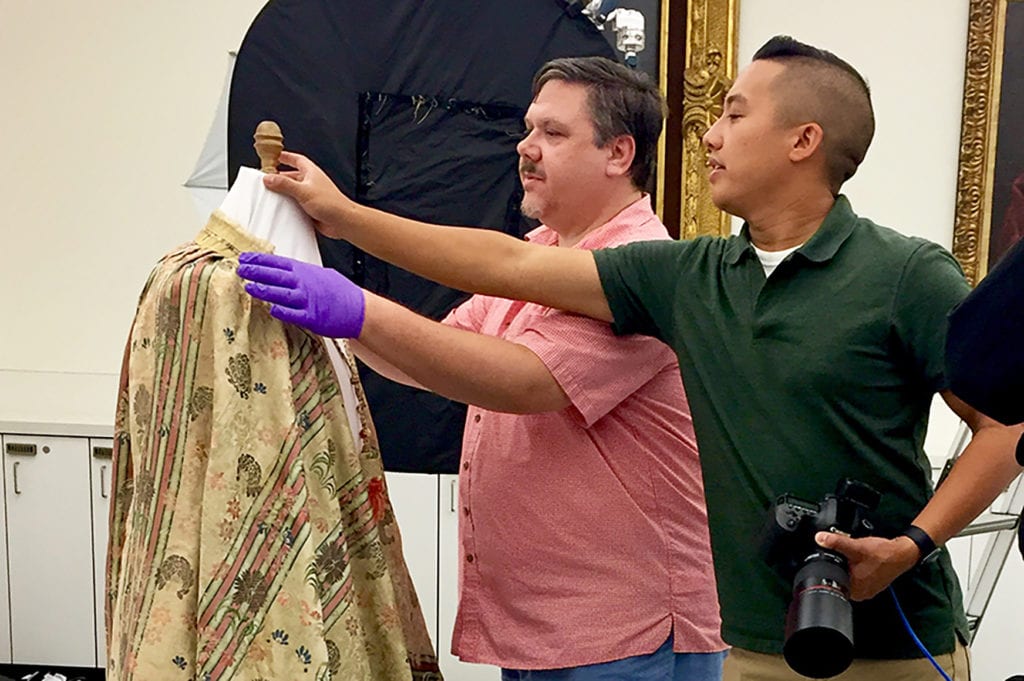
As textiles age they become increasingly delicate, even as their value as important historical artifacts can grow. With the goal of providing greater and permanent public access to these valuable, hidden collections located throughout the country, the Costume Society of America’s (CSA) endowment funded a pilot program called “Digital Angels” to train staff and volunteers, thus helping organizations digitize their holdings of dress. The first of three collections chosen to be digitized were the historic, mission and rancho-era (18th and 19th century) vestments held in the special collections of LMU’s William H. Hannon Library.
LMU Associate Professor of Theatre Arts Leon Wiebers and Dr. Monica Sklar from the University of Georgia serve on the Board of Directors of CSA and are co-leads on this project. Wiebers and Sklar led and trained a team of volunteer researchers, students, and librarians, in digitizing efforts and developing standards for metadata.
Most of the vestments were donated to LMU by Josefa del Valle de Forster, possibly in the 1930s. The del Valles were a prominent Californio family in the early 19th century, and played a significant role in the early history of Los Angeles from the Mexican period through California’s transition to statehood. The family was renowned for their gracious hospitality on their homestead, Rancho Camulos, and their vibrant working ranch was a stopover for many leading officials and Catholic clergy and later, tourists. The stunning vestments had been used in the family’s chapel, and their opulence affirms the prominent role textiles played in the lives of the del Valle women, both as an expression of their religious devotion, and their social standing as an influential family.
After LMU, the team digitized dress collections at the University of Georgia and the Peabody Essex Museum. In addition to Wiebers and Sklar, the LMU team included Cynthia Becht, Head of Archives and Special Collections for Hannon Library, undergraduate students, library staff, and CSA volunteers.
While the library has the ability to scan smaller, flat objects to create high-quality digital collections, external professional help was needed for the vestments because objects of dress require special handling, mounting, and can be very fragile. “I have always loved the vestments for their significant California history and physical gorgeousness,” said Becht. “They were on my ‘digital collection wish-list’ for quite some time. I wanted to advocate for them, and provide access to them, even though they are among our most fragile objects. Now, all that is possible.”
The process for digitizing the collection was painstaking and thorough. The funds from CSA allowed the hiring of professional photographers, supplies, and other resources. Wiebers and Sklar are working Arden Kirkland, a CSA member and a metadata expert who is developing a resource called “Costume Core Toolkit” based on Dublin Core, a standard metadata schema used by libraries, including LMU’s digital collections. Costume Core will enable the team to beta-test and eventually standardize metadata and nomenclature issues that plague the discipline. The team spent several days prepping the centuries-old vestments, dressing the mannequins, and then styling, photographing, entering the data, and carefully re-packing the collection in their storage boxes.
Wiebers and Sklar hope this project will pave the way for a nation-wide philanthropic program through CSA, and are working on obtaining grants from the National Endowment for the Humanities to support the plans. “The digitization of these gorgeous vestments is the first step in what I hope will be a much larger national effort,” Wiebers said. “We also aim to create an online, searchable portal connecting these collections of dress, preserving them for future researchers and scholars, and bringing more diverse and inclusive representations of dress online for and of the American public.”
Photos provided courtesy of Cynthia Becht




